For the past couple of years I've had the pleasure of climbing with Pete Robins. Quite often I've taken my camera and snapped a few shots, but I'm a climber at heart, not a photographer, so I've missed quite a few photo opportunities too. However, looking through my hard-drive I noticed that I had a large collection of Pete and so this photo-article sort of just happened by accident.
I asked various people to comment on these photo's – mainly Pete himself, but I did feel the need to write a short introduction:
If there is one thing I've learnt through climbing with Pete it's that one man's 'bomber runner' is another man's 'psychological runner'. The first man is Pete – the second man is me! Traditional climbing in the UK isn't about being the fittest or the strongest, it's about climbing extremely well and having the confidence in yourself and in your gear to really push to the limit. Sport grades become more and more meaningless as you progress on to harder and less-travelled trad routes. Pete's natural climbing skill has developed with years of experience and this really shows through when things start to get messy. On really hard and bold on-sight ascents all bravado and ego are left at the bottom, the only things that will get you to the top are true belief in yourself and a bucket full of climbing ability. Pete has both.
Jack Geldard - Editor - UKC
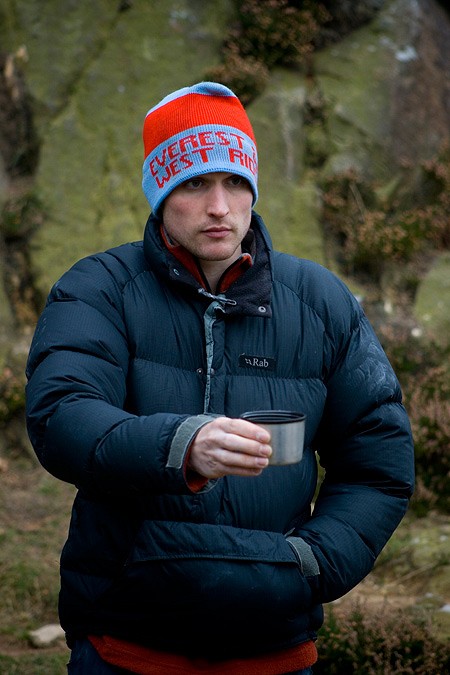
Interview with Pete Robins:
“There are no routes in the UK harder than E7, except the Indian Face at E9”
Jack: Whilst it was only a general throw away pub comment – something with this resonated with me. You spoke with a flash in your eyes; a hidden sense of conviction or just imp-like trouble causing - most likely a combination. As someone who has climbed a lot of E7's, several of them on sight, and someone who has top-roped the Indian Face – can you expand on this in some philosophical way?!
Pete: Not really, I was probably drunk and I don't remember saying that! What was I on about? Can I back it up? Er, well the Indian Face is a really hard route to lead, the hardest I've been on, obviously not physically, but you need some serious mental problems to go for it. I don't mean you have to be a retard or anything, just a bit suicidal. I suppose I meant that if the Indian Face is E9, nothing I've been on comes close to that. Also, routes above E7 haven't been on-sighted, bar a few amazing achievements on the border of E8. Therefore, the grades don't exist yet. No one can say they climb E8 or E9 and most ascents end up being equivalent to E5 or E6 when head-pointed, so the first part of that quote is right.
Jack: Why do you climb? Have you ever thought of stopping? Ever been unmotivated or not climbed for a while? Do things 'get in the way' of your climbing? If so – how do you overcome them?
Pete: Well I've always climbed. I don't think of climbing as a sport that I enjoy every weekend, it's what I do and have done since I could walk and climbing seems as natural to me as walking. I can't see me ever stopping, there's always HVS's! I have lost motivation a bit in the past, but not for climbing, more for trying hard. It's mentally taxing to always push your limit and if you fall behind, the slow slog back to fitness can be, well, slow. Of course things get in the way of climbing, work, relationships, but they are part of life and equally as enjoyable and important. Life isn't all about climbing, it's about having a good day and if you climbed every day, the days become ordinary. It's good to strike a balance.
Jack: If 'Top Trumps' cards existed for climbers – what would be the 6 characteristics on each card?
Pete:
- 1.Average route speed (moves per minute, leading of course). Open-ended value, 60 m.p.m being very good, 0.5 m.p.m. being very bad.
- 2.Crag fashion/style. Rated from 0-10, 0 being bad (e.g. tights with foot-loops, zip-offs, ¾ length slacks, vest-on-t-shirt combo, etc) and 10 being good (jeans, shirts, bow-ties, etc).
- 3.New route tally Open-ended value, Pat Littlejohn and Gary Gibson being top-trumps.
- 4.Overall skill Score out of 30, sub-divided into bouldering, sport climbing, and trad climbing (each scored out of 10)
- 5.Ape index, the greater the better.
- 6.Ran out of ideas!
Jack: And which characteristic would be the most important?!
Pete: Well if I was on the cards, I'd want a high skill value, but if I was belaying someone on the cards, I'd want them to have a high route speed!
Jack: Is there a climber who has inspired you with their achievements, either now or when you were starting out? Or are you more inspired by cliffs, lines, mountains – that sort of thing?
Pete: Lots of climbers have inspired me, mainly those who I've climbed with, where I've seen their ability first-hand. The best trad climbers I've seen are Ben Bransby, Leo Houlding and James McHaffie, they've all got slightly different talents but never fail to impress. People who I've not climbed with but their achievements speak for themselves are Ben Moon and Simon Nadin. So often I find myself struggling like hell on a sport route to find out later that one of these two machines flashed it about 20 years ago, amazing. Nic Sellers impresses me, he's climbed hard for 20 years and done everything and is still super-keen. Dave Birkett inspires me, like Caff, he's got super-human Cumbrian powers of gnarl and you could imagine either of them charging down the enemy on the front line in a medieval battle. When I lived in Sheffield, I was inspired by the two Johnny's (Allen and Dawes). Everyone knows their skills by the routes they did and I made it my mission to tick as many as I could. More recently on grit, Adam Long continues to raise my 'brows, although specialist, his gritstone palming skills are legendary. I should also mention Ryan Pasquill; I've dreamt a thousand times about on-sighting the End of the Affair and routes alike but never gone for them. He's gone out and flashed them in a no-nonsense unpretentious style, awesome and very inspiring. And yes, I'm also drawn to impressive routes and cliffs (probably to a greater extent than anything else); the territory, the line, the moves. Not mountains or summits, nice to look at but I don't lie awake at night thinking of mountains and summits.
“A grade is a grade, but you know a good climber when you see one”
Jack: Another pub comment – you'll have to learn to drink-up and shut-up when you're in the pub with me! Have you witnessed an impressive feat of climbing recently? By whom? Can you describe it and the way it impacted on you?
Pete: I can relate a bit more to that comment, although I also don't remember saying it. You hear people harping on about big grades but when it comes down to it, they'll struggle on a gnarly E4. You don't really know how good someone is until you climb with them. A bit pessimistic I know but this sport if full of lies, over-exaggerations and big egos. It would be much better if E-numbers didn't exist for head-points and they were just given a sport grade until they were on-sighted. Back to the question. I saw a friend struggle like hell on Rimsky Korsakov (E4/5) the other day, I think he'd not climbed for months and instantly got pumped and started shaking but just kept climbing and wouldn't let go. His gear looked shit and he could barely take a hand off to clip it but just carried on and scraped over the top. Awesome, that's what it's all about.
Jack: Finally, what are your climbing aspirations? Individual routes? Grades that you'd like to achieve? Experiences, places, people, mountains, money, fame, fortune?
Pete: There's lots I want to do but I've not set upon any must-do life experiences. I've got short-term local climbing goals and always look out for anything exciting that crops up on the way. I suppose I'm quite settled and content here in Wales, life is good, there's a great climbing scene with tons of routes to go at and everyone is friends and hangs out off the crag as well as on it. Work is a big commitment; I'm an oceanographic researcher in the university which leaves me little time for long holidays. I get away as much as possible, often preferring to go somewhere in Britain than aboard. I've travelled a lot in the past and believe that the best climbing is here on our tiny island, provided you get the weather.
Living in Llanberis:
Bouldering and the North Wales Scene - by Pete Robins
Climbing in North Wales in the summer is absolutely amazing. After work mid-week, everyone is out and psyched. There seems to be something new to do every night, even in the Llanberis Pass, which is like my back garden, being 1 minute away from my house. I must have climbed in the Pass a thousand times and the place is no way near worked out. I can just rock up at the Cromlech Boulders any evening all summer long and see a friendly face then bail up into esoterica and do an ace route. In the summer, I can't think of anywhere else I'd rather be.
Guest Comment from Chris Rowlands
DMM International Ltd:
Pete Robins shares many characteristics with another of our sponsored climbers; Ben Bransby. A little shy, unassuming, and modest about their achievements (a little bit like DMM actually!). Yet watch them perform on hard trad routes, ground-up and on-sight and you'll understand why they are at the top of their game. Pete has been a sponsored climber with DMM for about 7 years now - so what exactly does that mean? Do we set him targets? 'You must climb at least X amount of new routes', or 'you must appear on the front cover of X amount of magazines'. Absolutely not. We are proud to have the likes of Pete endorse our products, as that is one of the best adverts we could ask for. He knows the care and attention we put into the product, he knows we listen to his input in terms of product development, and we value his opinion and the opinions of the rest of our sponsored climbers. DMM has always had a grass-roots approach, having been founded by climbers and with our base here in Llanberis we maintain our close relationship with the climbing community of which Pete is a central figure. Pete is at the cutting edge of hard trad climbing and we like to think we do our bit to help him operate at this level, and are committed to supporting young talented climbers who share his approach.
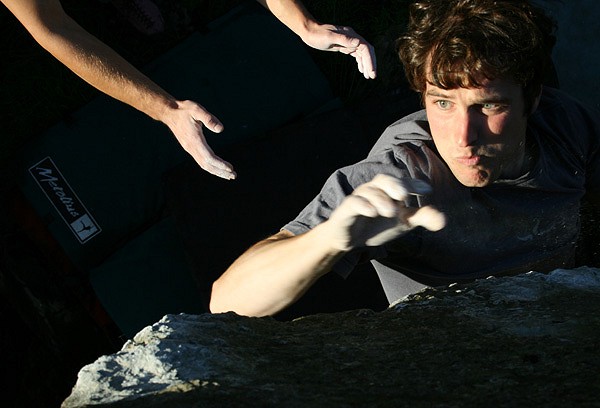
© Jack Geldard - Assistant Editor, Aug 2007 |
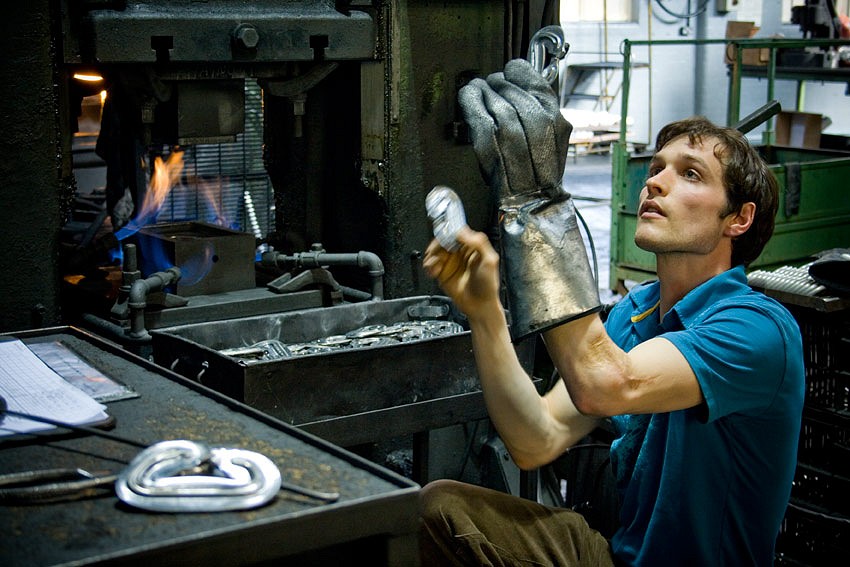
© Jack Geldard, May 2008 |
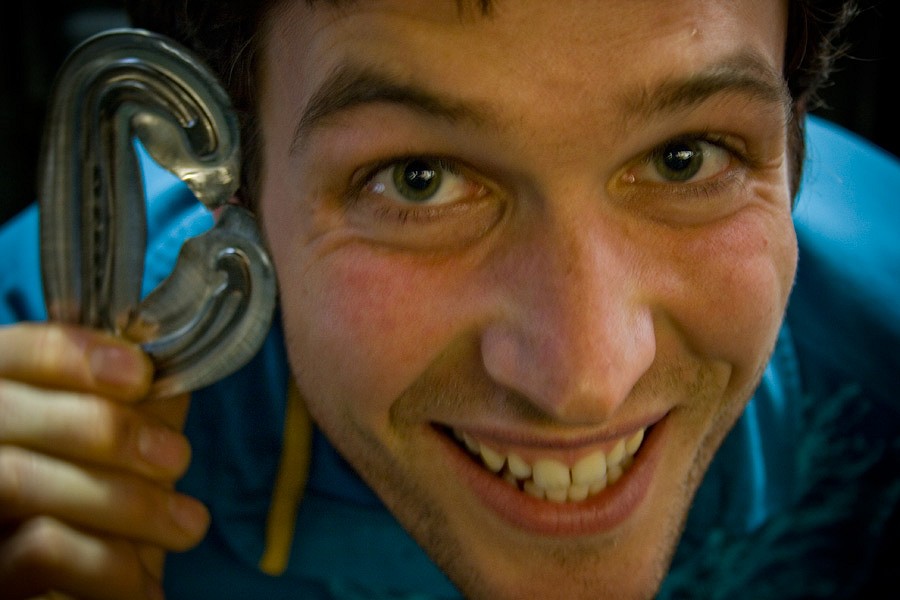
© Jack Geldard, May 2008 |
Slate Climbing in North Wales
Slate Renaissance – Misogynist's Discharge - by Pete Robins2007 was a slate renaissance. Slate is great. We had drills and bolts and a new way of looking at the quarries. New lines were predominantly sport climbs and some existing routes were re-bolted or, for specific cases, retro-bolted (with the permission of the first ascentionist). The quarries were and still are very popular again. Obviously, this change was not welcomed by all, but the majority of locals (past and present) who climb here day-in, day-out, are in-favour of the campaign. We haven't eradicated 'designer-danger' '80's-style chop routes, I like them, we've just improved the crap routes that were bolted on the cheap. I re-bolted Misogynist's Discharge (F8a+) in the hope of a quick repeat. Nearly a year later I clipped the chains. In the mid-'90's, it took Ben Moon about 30 seconds!
Guest Comment from Simon Panton
Ground-Up Publishing:
Pete has been a driving force in the new wave of hard slate routes in the last few years. The intensely technical style of slate suits him well; he has the same acute sense of balance and sure footed flamboyance that Dawes had in his prime. It can be quite incredible to watch, especially when he throws in one of his trademark heel hook manoeuvres and suddenly the seemingly impossible is overcome in a blur of gangly limbs (one of his nicknames is 'Golden Heels'). He climbs fast as well; almost instinctively seeing the best way to do a move and launching into it without doubt or hesitation. This adds a certain cartoonish (think: Harold Lloyd) quality to his climbing, funny to see, but disturbingly efficient.
He was actually quite flabby and unfit when he was trying Misogynist in 2007, but he still looked solid on it, at least until he fell off! It was interesting to see him shift up a gear over the winter of 2007/08 when he broke the magic Font 8a grade for the first time and then went on to break again into Font 8a+ with a first ascent of In Heaven in Parisella's Cave (Northwalesbouldering.com news) . He then applied this new level of bouldering power to climb The New Slatesman (F8b), a short, but very intense line that he had stopped him dead in his tracks the previous year. Aside from scoping out desperate new routes and boulder problems, Pete has also put a lot back into mainstream climbing. He has been one of the most prolific re-equippers in the quarries (along with Mark Reeves and Mark Dicken). It was not unusual to turn up at the V12 shop in Llanberis to collect the bolt fund drill, only to find that Pete was already out using it. He is also one of the key authors of the forthcoming Ground Up North Wales Slate guide, again, along with Mark Reeves and Mark Dicken.
The Llanberis climbing scene is buzzing at the moment, and people like Pete (and the two Marks, plus bolt fund organiser Chris Parkin and BMC Cymru chair, Mike Raine to mention a few other notable activists) can take much of the credit for that. If you see any of these people in the pub, buy them a pint (or two) – they've earned it many times over!
Tambourine Man - by Pete Robins
This was my first 'proper' new route in the quarries and one I'm proud of because of the superb technical climbing and the memories it holds. The route climbs an obvious corner in California and it astonished me that it was still unclimbed. I bolted it with Jack Geldard who was also keen for the first ascent, along with Spinal Crack in Ogwen. I wanted both routes but suggested a trade off and a continuation of our friendship! The climbing is very technical but once you've figured it out, you can do it every time. Tambourine Man is named in memory of my late friend Will Perrin, who overlooks the route in the form of a Rowan tree.
The New Slatesman - by Pete Robins
The route is shorter than it looks; a boulder problem really. Very good though. It's hard to grade slate routes and even harder to grade slate boulder problems, especially when they are height and rubber dependent. I had a real battle on my hands trying to beat James McHaffie to the first ascent. Neither of us had enough power for the crux but James was definitely ahead. I bolted it and felt it was mine so 'suggested' that he go find his own project. Kindly he did and the quarries now have two new excellent F8b's.
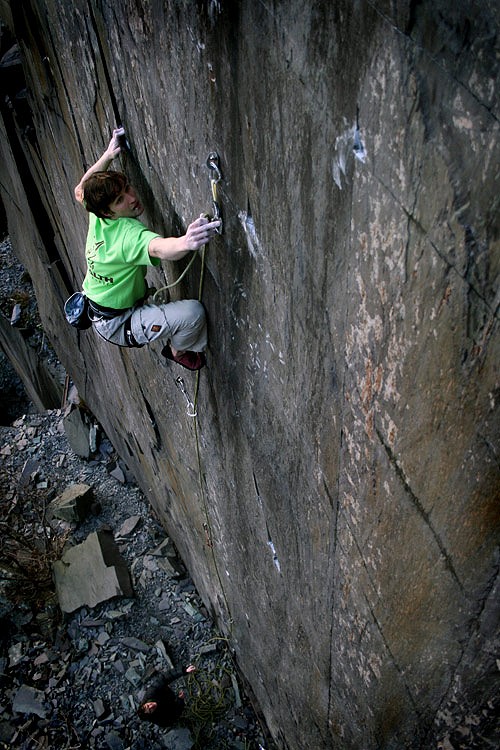
© Jack Geldard - Assistant Editor, Mar 2007 |
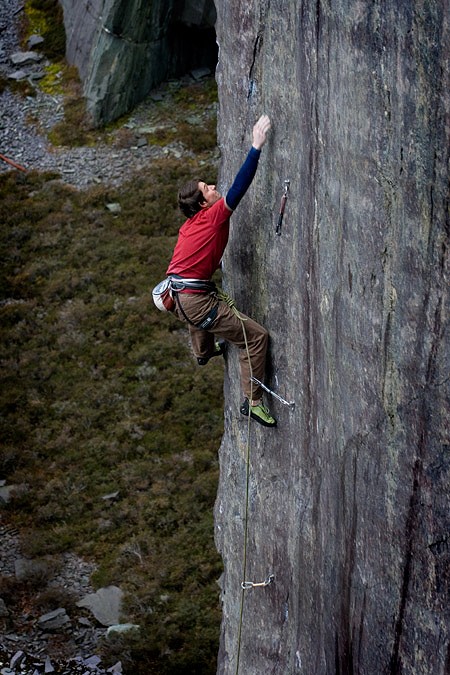
© Jack Geldard, May 2008 |

© Jack Geldard, May 2008 |
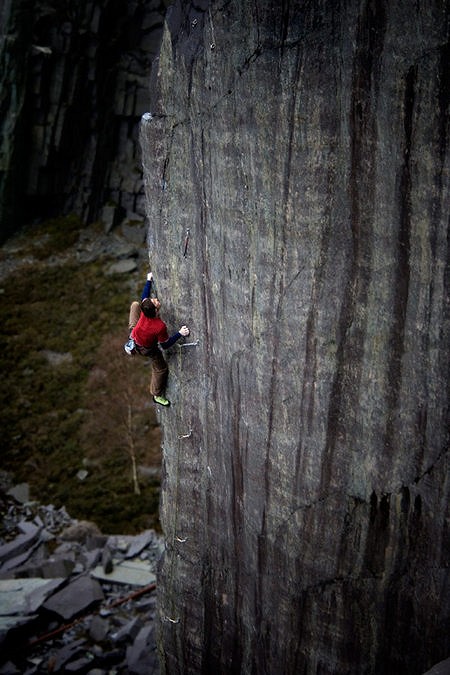
© Jack Geldard |
Growing Up On Gritstone, from Apprentice to Master
Gritstone- by Pete Robins
I was born and grew up in Sheffield. My dad climbed regularly (and still does) and took me out to the Peak most weekends from the age of 3; a perfect apprenticeship and a good grounding for both technique and bottle. Grit is nearly perfect, just a little rough for me and not close enough to Wales. I'd definitely swap Burbage Valley for Ogwen, or Curbar for Cloggy perhaps.
Guest Comment from Phil Robins
Pete's Father, Owner of The Edge Climbing Wall:
Looking back to Pete's childhood, now nearly 30 years ago, the memories I have today are still so clear and vivid, It really was a special time...
The family moved from the Midlands to Sheffield in 1979: as a climber with two young lads to bring up, it was obvious that living next door to The Peak was the perfect location for me to maintain a sane family life. I never really considered that the boys wouldn't become climbers, it just seemed logical! Pete was scrambling in The Peak most weekends even before going to school, which interestingly he could get to by climbing over our back garden wall. Pete and his elder brother Tom had the opportunity to taste adventure from an early age, with holidays regularly spent in remote parts of Scotland, North Wales, trekking in The Picos de Europa or skiing in the French Alps, it was natural that they would be at home in a challenging environment.
I always took the boys trad climbing, really because it's where my roots were, having started climbing in the late 60's. Single or multi-pitch, I would lead on two ropes, tie each of the boys to a single rope and they would follow - usually together, it seemed to work. Pete really started to get keen in his early teens. He attended the same Sheffield senior school as John Allen, a great Gritstone pioneer, and with school only ten minutes drive from Stanage, Pete was perfectly placed to start his Gritstone apprenticeship.
Once he had started to lead that was it, he was really hooked. His after school homework was literally spent honing techniques on the local Grit crags. Teaching your kids to trad lead is one of the more scary experiences for a parent to go through. Pete had taken enough gear out of routes to understand what was required, so I gave him my rack and tried to select straight-forward routes for him to try. Trying to guess the quality of your offspring's gear from the ground whilst belaying is a chapter yet to be written in the handbook of climbing! Pete's enthusiastic cries of; “It's Okay Dad it's bomber” didn't stop me from saying; "No more slack until you get another piece in!"
Pete's progress was not all plain sailing. His technical ability to progress through the grades was really ahead of his experience. He was just so keen to push his limits with little regard for consolidating at a grade. As soon as he could lead VS he wanted to try HVS and then he made equally fast progress through the E grades! This rapid pace did lead to a few close encounters. I vividly recall Pete setting off up Checkers Crack a notorious HVS at Froggatt which has quite a technical crack to start leading up to a ledge at about 8m. His one large Hex runner was urgently placed almost without stopping: sketchy footwork made things look ominous. I shouted, “Pete, don't kick out your runner,” too late - out came the runner with Pete at the top of the crack and with no gear in, arms cramping and about to fall, he got a very panicky Hex half into a crack and just managed to clip it on the point of falling off. That was a close call, but one that he learnt from.
Another memory was a day spent climbing those truly awesome routes at Cratcliffe Tor: Pete was leading Five Finger Exercise (E2 5c) which has a brilliant finale ascending a spectacular hanging layback flake and is quite run out. Pete, right at the top of the flake totally spent, shouts down; “I cant see how to finish” I was thinking this is going to be a really big fall and shouted up “there are some really good jams”. Pete's reply; “I cant see any, what do I do?” “They are right in front of you, but if you can't find any then try reversing to reduce the fall!” At which point Pete takes a huge jump, landing on a ledge to the right without coming on to the rope saying “I haven't weighted the rope so can I still claim the on-sight!?" The problem was that Pete had only been used to jamming in vertical cracks, and hadn't realised that the jams I was shouting for him to use were in a horizontal break! Again ability and determination to progress running a little faster than his all round experience! But I guess those calls make you mentally stronger and wiser.
I do have such good memories of what was a magical few years spent working together through the Peak trade routes, gradually seeing him develop into a brilliant on-sight adventure climber who all too quickly started to lead routes I could barely follow. With the apprenticeship now complete in the summer before Pete left Sheffield to move to Wales and start at Bangor University, we shared a brilliant holiday in Yosemite climbing together on some wonderful routes on the tranquil domes of Tuolumne, culminating in Pete taking his old Dad up The classic NW Face of Half Dome - a fantastic route. The day was memorably capped by startling trekkers on the summit as they stood gaping over the 2000ft vertical wall, who, upon realising we were a Father & Son team, produced a bottle of Champaign for us to drink! You couldn't script it!
Masters Edge- by Pete Robins
It was obvious to me as soon as I understood ethics that this route was not to be top-roped. It's not a chop-route and you can fall if your belayer is not eating his sandwiches. Its likely that you'll take a monster ground-sweeping fall and that terrified me. I had a brief attempt a few years back but was so scared about blowing the top that I wouldn't commit to the drill holes - I just climbed back down and resigned myself to the fact that I'd never get up the route. That was until I came along with Caff in 2007 to belay him on it. I had thoughts of on-sighting it but was just going along with his psyche and didn't really expect anything. He kept saying that he wouldn't try it unless I'd have a go after him. After he shot up the lower half, I expected him to be on top in about 1 minute but he hit a stopper move and impressively down-climbed. This really fired me up and my competitive streak kicked in. This is when I climb my best, when someone's laid a goal-post down for me to surpass, and when I'm excited about going into unknown territory. This only happens on on-sight attempts, after that there is familiarity and a red/head-point stress comes into play. I was up on the top arête in no time and had worked out a way to get past Caff's stopper move when my foot slipped. I took a big whipper and landed a few feet off the deck. This was a good marker-fall; blowing the top move would be a close call but I felt I would be fine and got straight back on. This time I got more pumped but just climbed quicker to my high-point on auto-pilot. Suddenly I was eyeing up the top thank-god jug and my mind kept switching from telling me to go for it or let go. I naturally wanted to let go but thought I'd never be here again and I'd always regret not going for it, so I took a deep breath and laid one on. Phew! This piled the pressure back on Caff like a ton of bricks, it took some doing, but he rose to the challenge, took his top off (it was sub-zero temperatures!) and pissed it, making the first ground-up, no-falls ascent of this amazing route and setting the bench-mark for future ascents.
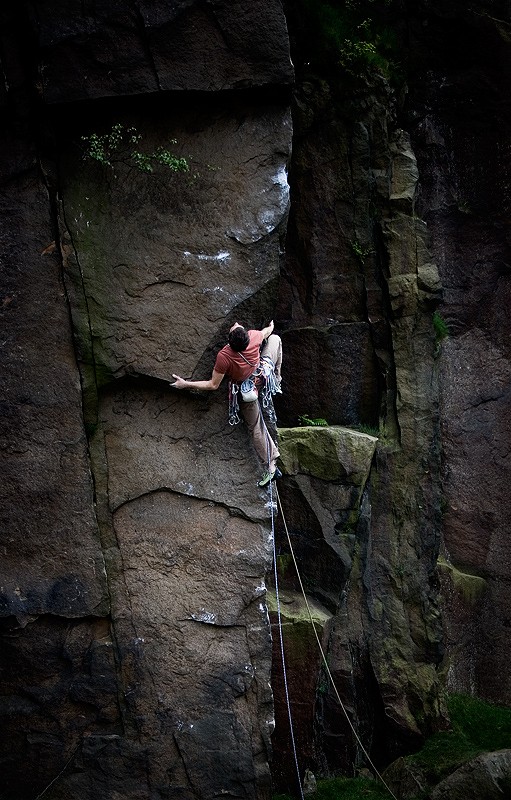
© Jack Geldard - Editor - UKC, May 2008 |

© Jack Geldard, May 2008 |

© Phil Robins |
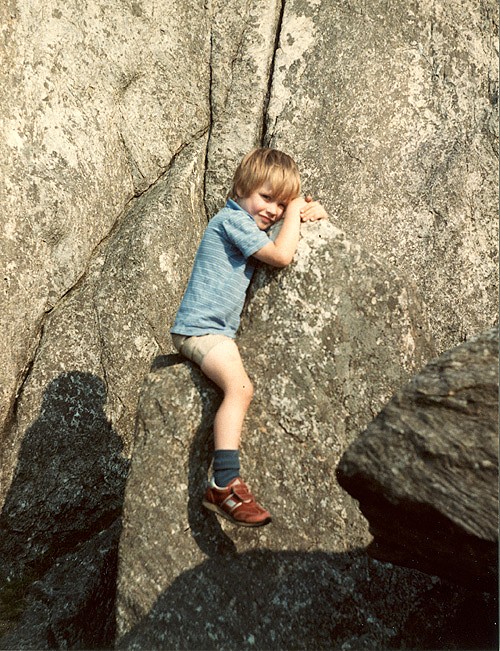
© Phil Robins |
'Sarnies', Bouldering and Onsighting - The Three Main Aspects of Climbing
Sandwiches- by Pete Robins
I love food nearly as much as climbing, or is that the other way round? I seem to plan my climbs around lunch which usually consists of an innovative mix of sandwich fillings. The excitement of two ingredients not yet tested together is quite something. I once went to Ceuse and only averaged 1.4 routes per day as the sandwich digestion period consumed the major part of the day. On the (pictured) trip to Font, a massive tray of baguettes, cheeses and meats were brought to the crag every day to feed 15 or so of us. This was obviously detrimental to our achievements. Man, if I held back on lunch at the crag I'd be climbing V16!
On-sighting - by Pete Robins
On-sighting near your limit is so hard! The uncertainty and fear can hold you back far from your physical ability. Every decision you make undergoes a lengthy boardroom meeting in your head, slowing you right down to the pace of a stoned snail and filling your mind with doubt. However, these mental complexities add such a great and addictive challenge to the experience and one I really relish. Recent progress in on-sighting has been slower than other aspects of the sport, probably because they were so mad in the 80's and videos made head-pointing fashionable in the 90's, but it is still moving forward. I think team psyche is the future, and flash/ground-up ascents of really hard stuff will go down. Two or three mates all going for it, gunning for each other with some 'healthy' competition makes a hell of a difference and so much more can be achieved than from a lonely on-sight.
Fontainebleau - by Pete Robins
This is the best place to climb on Earth. I've been here once or twice a year for the last 10 years and just can't get enough of the place. It so peaceful, I manage to completely switch off from life and get engrossed in the climbing. Unfortunately, the rocks have to fight hard against poffers, sandy trainer climbers and tick-markers to keep their unique charm.
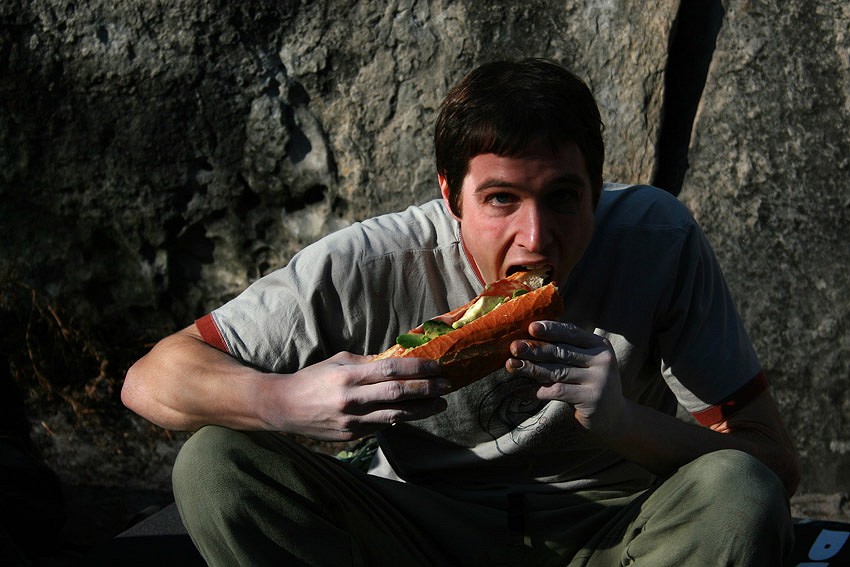
© Jack Geldard, May 2008 |

© Jack Geldard - Assistant Editor, Sep 2007 |
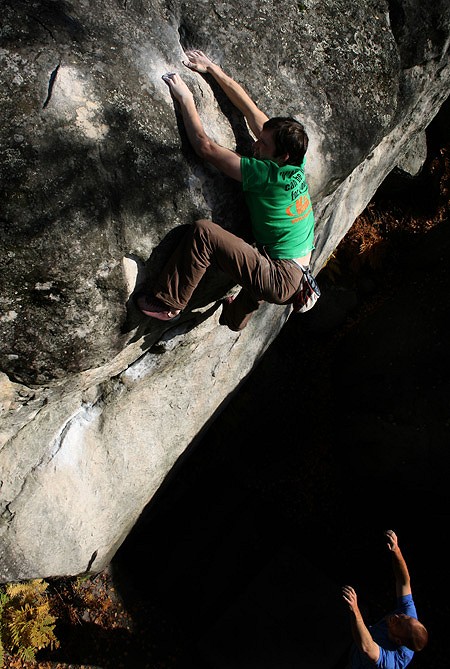
© Jack Geldard, May 2008 |



Comments